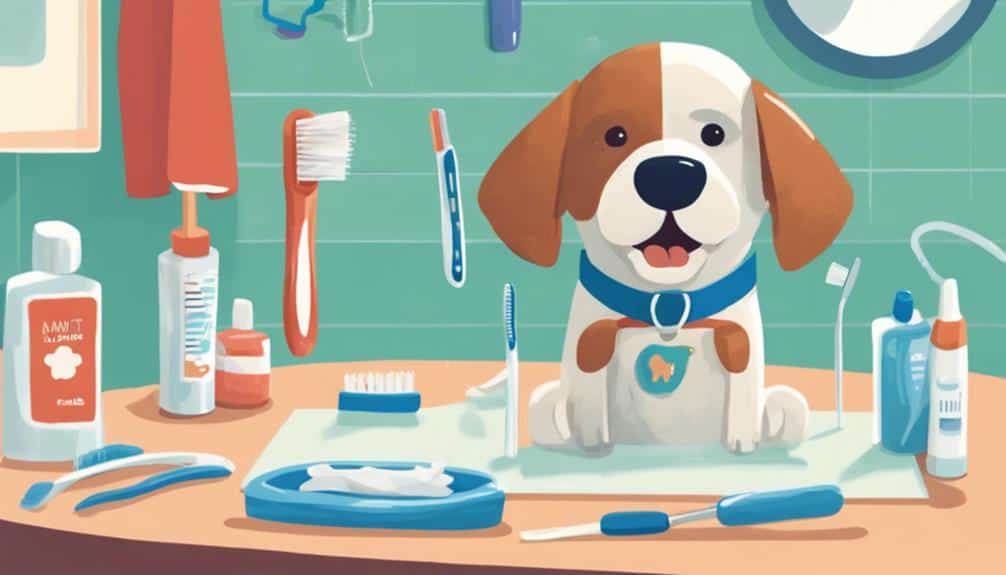To brush your dog's teeth effectively, start by preparing them for the process, familiarizing them with mouth handling and introducing pet toothpaste gradually. Next, choose the right toothbrush designed for dogs, selecting the right size based on your dog's weight. Get your dog accustomed to the sensation by introducing tooth brushing gradually and rewarding calm behavior. Then, brush their teeth gently with a soft-bristled toothbrush, focusing on the gum line, and make it a fun routine by incorporating positive reinforcement and rewards. As you master these steps, you'll uncover the secrets to a healthier, happier pup.
Key Takeaways
• Prepare your dog for brushing by familiarizing them with mouth handling and introducing toothpaste gradually to avoid discomfort or anxiety.
• Choose a toothbrush designed for dogs, selecting the right size based on your dog's weight and breed to ensure a comfortable fit.
• Introduce tooth brushing gradually, handling your dog's mouth gently and rewarding calm behavior with treats and praise to create a positive association.
• Brush your dog's teeth gently with a soft-bristled toothbrush, using circular motions to remove plaque and focusing on the gum line where bacteria accumulate.
• Establish a consistent daily routine for brushing, incorporating positive reinforcement and rewards to make oral health care a fun and enjoyable experience for your dog.
Prepare Your Dog for Brushing
Before you start brushing your dog's teeth, it's important to prepare them for the process to guarantee a stress-free experience for both you and your pet. Familiarize your dog with mouth handling by gently lifting their lips and touching their teeth. This will help them get comfortable with the sensation of having their teeth touched.
Next, introduce pet toothpaste gradually to get your dog used to the taste and texture. Let them lick it off your finger to acclimate them to the sensation. This will help them accept the toothpaste and reduce anxiety during brushing. As your dog becomes more comfortable, start brushing their canine teeth before progressing to their molars.
Remember to brush all surfaces, including the tongue side, to ensure a thorough dental cleaning. Gradually increase the brushing time as your dog becomes more comfortable with the process. By following these steps, you'll set the stage for a successful and stress-free brushing experience for both you and your dog.
Choose the Right Toothbrush
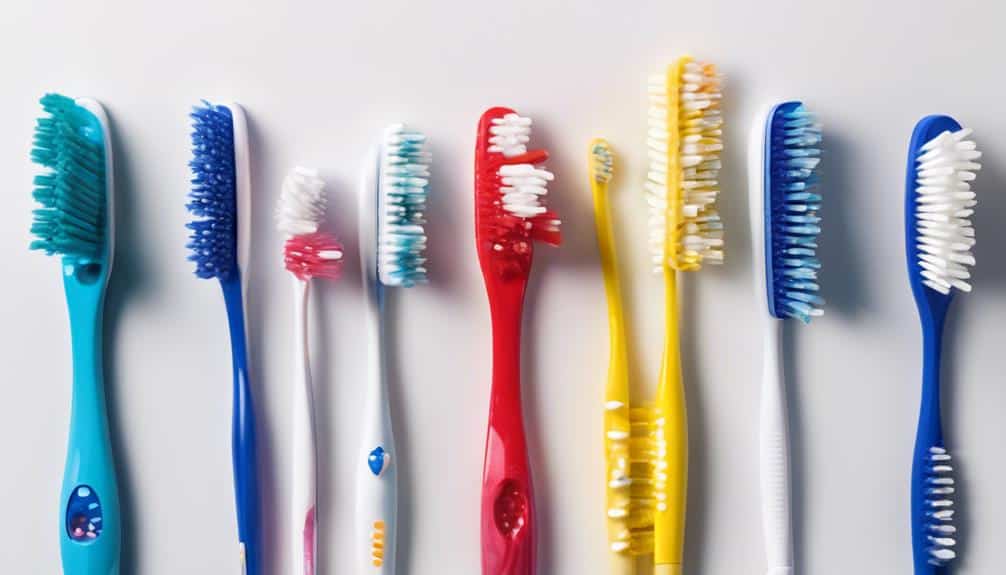
Now that your dog is comfortable with the idea of tooth brushing, it's time to select the right toothbrush for their oral care needs. Choosing the right toothbrush is essential to guarantee effective cleaning and a pleasant experience for your dog.
Here are some tips to keep in mind when selecting a toothbrush for your dog:
- Use a toothbrush specifically designed for dogs: These toothbrushes are tailored to accommodate the unique shape of a dog's mouth and teeth.
- Choose the right size: For small dogs under 30 pounds, finger brushes are ideal for easier access. For larger dogs, opt for longer-handled brushes to reach all teeth effectively.
- Select a toothbrush that complements your dog's size and breed: This will ensure a comfortable and effective brushing experience.
Get Your Dog Accustomed
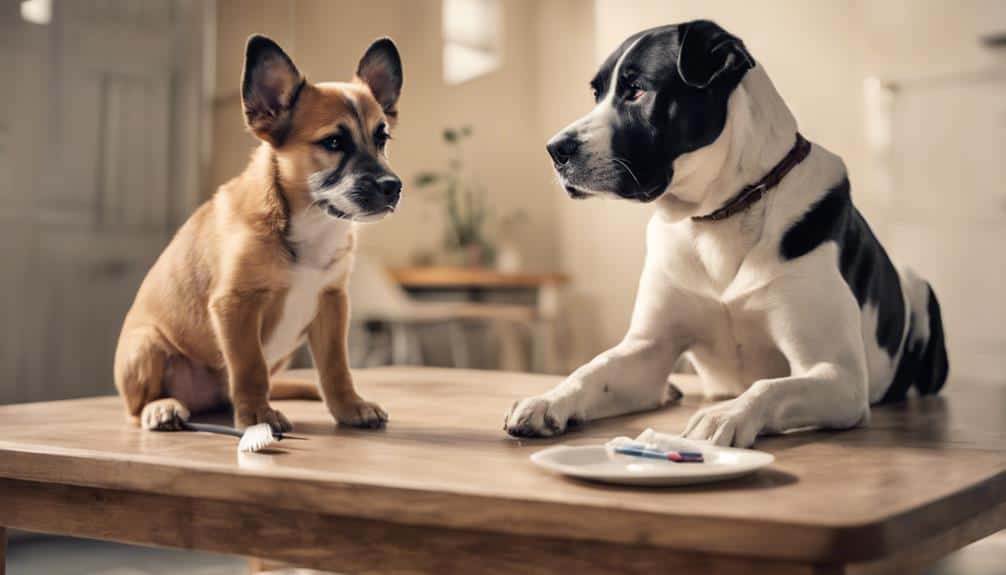
Gently introduce your dog to the sensation of tooth brushing by handling their mouth and rewarding them with treats and praise. This initial step helps your dog become comfortable with the idea of someone touching their mouth and teeth.
Take your time, and in a quiet time and place, gently rub your finger over your dog's back teeth, gradually introducing the sensation. As your dog becomes more relaxed, apply a small amount of toothpaste to your finger and let them taste a little bit. This allows them to get used to the flavor and texture.
Positive reinforcement is key, so be sure to reward your dog with treats and praise for their calm behavior. By taking it slow and gentle, your dog will begin to accept the idea of tooth brushing, making it easier to brush those teeth and prevent plaque buildup.
Brush Those Teeth Gently
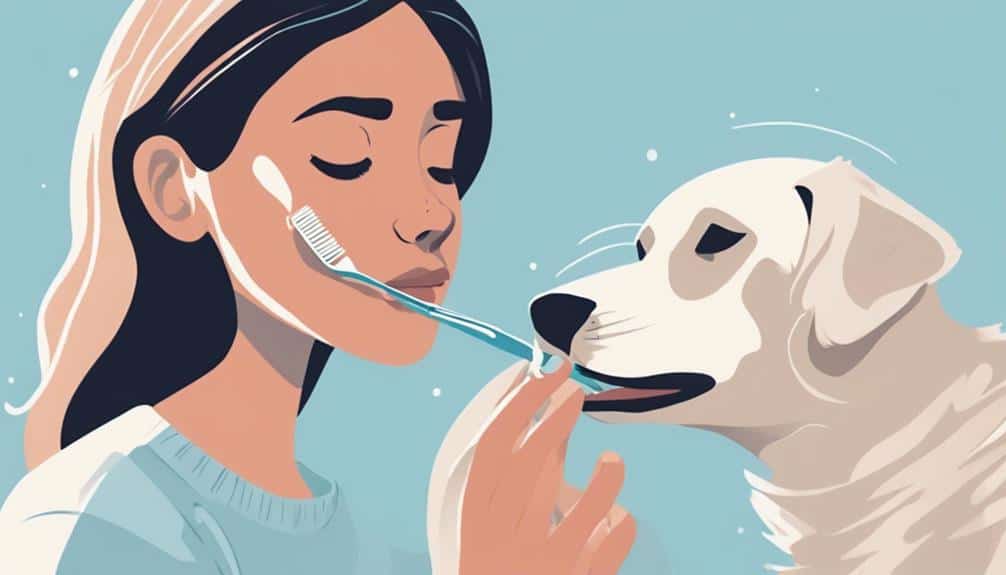
You'll need a soft-bristled toothbrush designed specifically for dogs to avoid damaging their gums as you start brushing those teeth. This is essential for effective dental care and to prevent oral health issues.
As you begin brushing your dog's teeth, remember to use gentle circular motions to remove plaque and food particles.
Here are some key techniques to keep in mind:
- Focus on the gum line: This is where bacteria tend to accumulate and cause dental issues, so make sure to brush thoroughly in this area.
- Brush both outer and inner surfaces: Don't forget to clean the inner surfaces of the teeth to ensure a thorough cleaning.
- Gradually increase brushing time: As your dog becomes more comfortable with the brushing process, you can gradually increase the time spent brushing their teeth.
Make It a Fun Routine
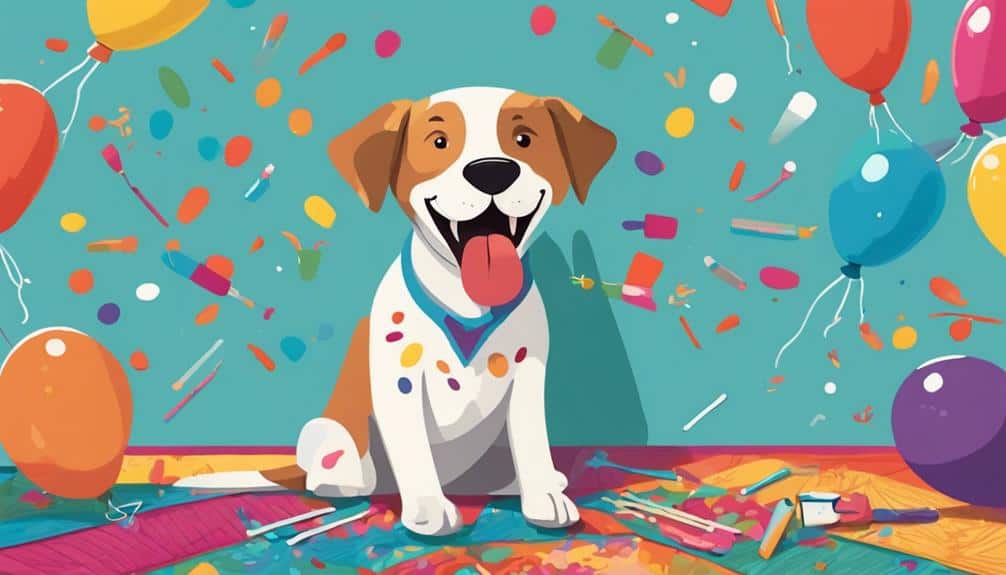
Establish a consistent daily routine for brushing your dog's teeth, and make it a fun experience by incorporating positive reinforcement and rewards. This will help create a calm and relaxed environment, reducing stress during brushing sessions.
As you brush your dog's teeth, use gentle and soothing movements to help them feel comfortable and safe. By making teeth brushing a fun activity, you'll reduce stress and create a positive association with oral health.
Consistency is key in making tooth brushing a fun routine. Set aside a specific time each day for daily brushing, and stick to it. This will help maintain your dog's oral health in the long run.
Positive reinforcement and rewards will encourage your dog to look forward to teeth brushing, making it a stress-free experience. By creating a safe environment and incorporating gentle movements, you'll help your dog feel relaxed and comfortable during brushing sessions.
Frequently Asked Questions
What Is the Safest Way to Brush a Dog's Teeth?
Coincidentally, you're wondering what's the safest way to brush your dog's teeth, and it's essential you get it right!
You'll need a toothbrush specifically designed for dogs, as human toothbrushes can be too harsh.
Next, ditch the human toothpaste, as it can be toxic if swallowed. Instead, opt for a dog-friendly paste.
Now, grab that brush and get brushing at a 45-degree angle, starting with gentle circular motions on the outer surfaces.
How Can I Get Plaque off My Dog's Teeth?
You're wondering how to get plaque off your dog's teeth. The key is to remove it regularly before it hardens into tartar.
Use a dog-specific toothbrush and toothpaste, and gently brush in circular motions, focusing on areas where the teeth and gums meet. Be gentle, as dog gums can be sensitive.
Brushing daily is ideal, but aim for at least 3-4 times a week to effectively remove plaque and prevent its buildup.
How Do You Properly Brush a Dog?
You're enthusiastic to give your furry friend a sparkling smile! Imagine Max, a golden retriever, who loves treats and praise during brushing sessions.
To properly brush your dog's teeth, start with a dog-specific toothbrush and toothpaste. Hold your dog's lip up, and gently brush teeth at a 45-degree angle, using a back-and-forth motion.
Take breaks for treats and praise to make the experience enjoyable and stress-free.
How to Keep Dog's Mouth Open to Brush Teeth?
When it's time to brush your dog's teeth, you'll need to keep their mouth open. To do this, gently hold their upper jaw with one hand and use the other to lift their lips. Avoid forcing their mouth open, as this can cause anxiety.
Instead, gradually increase the time they can keep their mouth open during brushing sessions, rewarding them with treats and praise for their cooperation.
